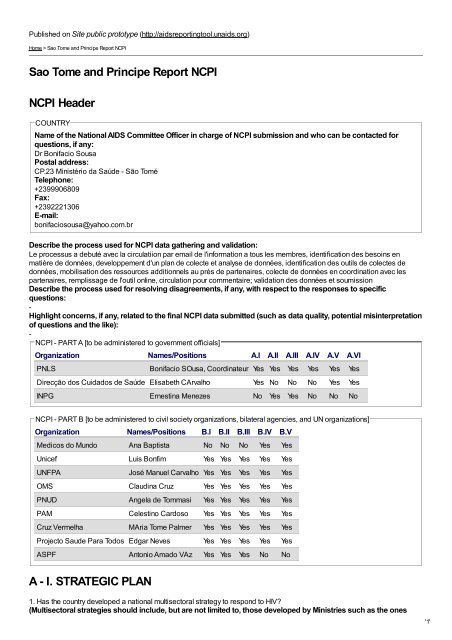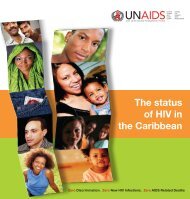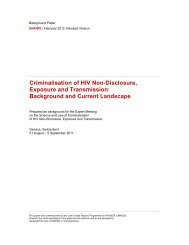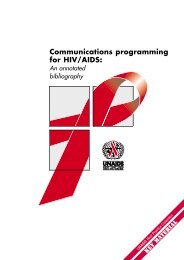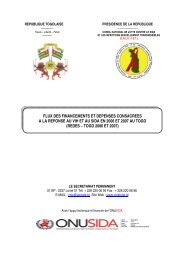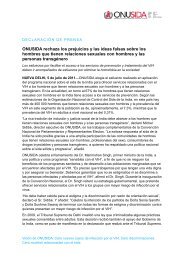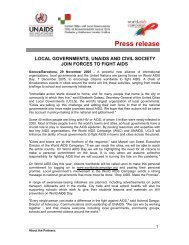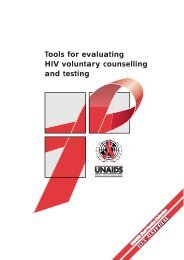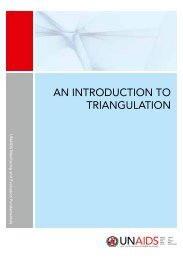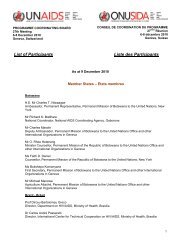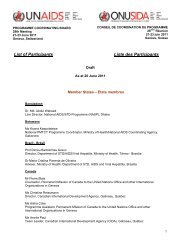National Commitments and Policies Instrument (NCPI ... - UnAIDS
National Commitments and Policies Instrument (NCPI ... - UnAIDS
National Commitments and Policies Instrument (NCPI ... - UnAIDS
You also want an ePaper? Increase the reach of your titles
YUMPU automatically turns print PDFs into web optimized ePapers that Google loves.
Published on Site public prototype (http://aidsreportingtool.unaids.org)<br />
Home > Sao Tome <strong>and</strong> Principe Report <strong>NCPI</strong><br />
Sao Tome <strong>and</strong> Principe Report <strong>NCPI</strong><br />
<strong>NCPI</strong> Header<br />
COUNTRY<br />
Name of the <strong>National</strong> AIDS Committee Officer in charge of <strong>NCPI</strong> submission <strong>and</strong> who can be contacted for<br />
questions, if any:<br />
Dr Bonifacio Sousa<br />
Postal address:<br />
CP.23 Ministério da Saúde - São Tomé<br />
Telephone:<br />
+2399906809<br />
Fax:<br />
+2392221306<br />
E-mail:<br />
bonifaciosousa@yahoo.com.br<br />
Describe the process used for <strong>NCPI</strong> data gathering <strong>and</strong> validation:<br />
Le processus a debuté avec la circulatiion par email de l'information a tous les membres, identification des besoins en<br />
matière de données, developpement d'un plan de colecte et analyse de données, identification des outils de colectes de<br />
données, mobilisation des ressources additionnels au près de partenaires, colecte de données en coordination avec les<br />
partenaires, remplissage de l'outil online, circulation pour commentaire; validation des données et soumission<br />
Describe the process used for resolving disagreements, if any, with respect to the responses to specific<br />
questions:<br />
-<br />
Highlight concerns, if any, related to the final <strong>NCPI</strong> data submitted (such as data quality, potential misinterpretation<br />
of questions <strong>and</strong> the like):<br />
-<br />
<strong>NCPI</strong> - PART A [to be administered to government officials]<br />
Organization Names/Positions A.I A.II A.III A.IV A.V A.VI<br />
PNLS Bonifacio SOusa, Coordinateur Yes Yes Yes Yes Yes Yes<br />
Direcção dos Cuidados de Saúde Elisabeth CArvalho Yes No No No Yes Yes<br />
INPG Ernestina Menezes No Yes Yes No No No<br />
<strong>NCPI</strong> - PART B [to be administered to civil society organizations, bilateral agencies, <strong>and</strong> UN organizations]<br />
Organization Names/Positions B.I B.II B.III B.IV B.V<br />
Medicos do Mundo Ana Baptista No No No Yes Yes<br />
Unicef Luis Bonfim Yes Yes Yes Yes Yes<br />
UNFPA José Manuel Carvalho Yes Yes Yes Yes Yes<br />
OMS Claudina Cruz Yes Yes Yes Yes Yes<br />
PNUD Angela de Tommasi Yes Yes Yes Yes Yes<br />
PAM Celestino Cardoso Yes Yes Yes Yes Yes<br />
Cruz Vermelha MAria Tome Palmer Yes Yes Yes Yes Yes<br />
Projecto Saude Para Todos Edgar Neves Yes Yes Yes Yes Yes<br />
ASPF Antonio Amado VAz Yes Yes Yes No No<br />
A - I. STRATEGIC PLAN<br />
1. Has the country developed a national multisectoral strategy to respond to HIV?<br />
(Multisectoral strategies should include, but are not limited to, those developed by Ministries such as the ones<br />
'1'
listed under 1.2):<br />
Yes<br />
IF YES, what was the period covered:<br />
2011-2015<br />
IF YES, briefly describe key developments/modifications between the current national strategy <strong>and</strong> the prior one.<br />
IF NO or NOT APPLICABLE, briefly explain why.:<br />
La revue du plan strategique 2004-2008 a été faite en 2007 et demarrage du processus de planification en vue de<br />
l'integration des objectifs d'acès universel, prevention, soins et tratitement en 2010<br />
1.1 Which government ministries or agencies<br />
Name of government ministries or agencies [write in]:<br />
Ministry of Health <strong>and</strong> Social Affaires<br />
1.2. Which sectors are included in the multisectoral strategy with a specifc HIV budget for their activities?<br />
SECTORS<br />
Included in Strategy Earmarked Budget<br />
Yes Yes<br />
Yes Yes<br />
Yes -<br />
Yes -<br />
Yes -<br />
Yes -<br />
- -<br />
Other [write in]:<br />
-<br />
IF NO earmarked budget for some or all of the above sectors, explain what funding is used to ensure<br />
implementation of their HIV-specifc activities?:<br />
-<br />
1.3. Does the multisectoral strategy address the following key populations, settings <strong>and</strong> cross-cutting issues?<br />
Men who have sex with men:<br />
Yes<br />
Migrants/mobile populations:<br />
Yes<br />
Orphans <strong>and</strong> other vulnerable children:<br />
Yes<br />
People with disabilities:<br />
No<br />
People who inject drugs:<br />
Yes<br />
Sex workers:<br />
Yes<br />
Transgendered people:<br />
No<br />
Women <strong>and</strong> girls:<br />
Yes<br />
Young women/young men:<br />
Yes<br />
Other specific vulnerable subpopulations:<br />
No<br />
Prisons:<br />
Yes<br />
Schools:<br />
Yes<br />
Workplace:<br />
Yes<br />
Addressing stigma <strong>and</strong> discrimination:<br />
Yes<br />
Gender empowerment <strong>and</strong>/or gender equality:<br />
Yes<br />
'2'
HIV <strong>and</strong> poverty:<br />
Yes<br />
Human rights protection:<br />
Yes<br />
Involvement of people living with HIV:<br />
Yes<br />
IF NO, explain how key populations were identifed?:<br />
-<br />
1.4. What are the identified key populations <strong>and</strong> vulnerable groups for HIV programmes in the country [write in]?:<br />
Adolescents et jeunes; hommes en tenue; population carcelare; population mobile et pecheurs; les populations plus a risque<br />
(travailleures de sexe et leurs clients; HSH, Usager de drogues injectables).<br />
1.5. Does the multisectoral strategy include an operational plan?: No<br />
1.6. Does the multisectoral strategy or operational plan include<br />
a) Formal programme goals?:<br />
Yes<br />
b) Clear targets or milestones?:<br />
Yes<br />
c) Detailed costs for each programmatic area?:<br />
No<br />
d) An indication of funding sources to support programme implementation?:<br />
No<br />
e) A monitoring <strong>and</strong> evaluation framework?:<br />
No<br />
1.7<br />
1.7. Has the country ensured “full involvement <strong>and</strong> participation” of civil society in the development of the<br />
multisectoral strategy?:<br />
Active involvement<br />
IF ACTIVE INVOLVEMENT, briefly explain how this was organised:<br />
PVVIH, NGO's representants, Education, representant de la jeunesse, de la communication, dans l'analyse situational et<br />
dans l'identification des strategies.<br />
1.8. Has the multisectoral strategy been endorsed by most external development partners (bi-laterals, multilaterals)?:<br />
No<br />
1.9<br />
1.9. Have external development partners aligned <strong>and</strong> harmonized their HIV-related programmes to the national<br />
multisectoral strategy?:<br />
Yes, all partners<br />
2. Has the country integrated HIV into its general development plans such as in: (a) <strong>National</strong> Development Plan;<br />
(b) Common Country Assessment / UN Development Assistance Framework; (c) Poverty Reduction Strategy; <strong>and</strong><br />
(d) sector-wide approach?:<br />
Yes<br />
2.1. IF YES, is support for HIV integrated in the following specifc development plans?<br />
Common Country Assessment/UN Development Assistance Framework:<br />
Yes<br />
<strong>National</strong> Development Plan:<br />
Yes<br />
Poverty Reduction Strategy:<br />
Yes<br />
Sector-wide approach:<br />
N/A<br />
Other [write in]:<br />
-<br />
2.2. IF YES, are the following specifc HIV-related areas included in one or more of the development plans?<br />
HIV impact alleviation:<br />
Yes<br />
Reduction of gender inequalities as they relate to HIV prevention/treatment, care <strong>and</strong>/or support:<br />
Yes<br />
Reduction of income inequalities as they relate to HIV prevention/treatment, care <strong>and</strong>/or support:<br />
'3'
Yes<br />
Reduction of stigma <strong>and</strong> discrimination:<br />
Yes<br />
Treatment, care, <strong>and</strong> support (including social security or other schemes):<br />
Yes<br />
Women’s economic empowerment (e.g. access to credit, access to l<strong>and</strong>, training):<br />
Yes<br />
Other[write in below]:<br />
-<br />
3. Has the country evaluated the impact of HIV on its socioeconomic development for planning purposes?:<br />
-<br />
4. Does the country have a strategy for addressing HIV issues among its national uniformed services (such as<br />
military, police, peacekeepers, prison staff, etc)?:<br />
Yes<br />
5. Has the country followed up on commitments made in the 2011 Political Declaration on HIV/AIDS?:<br />
No<br />
5.1. Have the national strategy <strong>and</strong> national HIV budget been revised accordingly?:<br />
No<br />
5.2. Are there reliable estimates of current needs <strong>and</strong> of future needs of the number of adults <strong>and</strong> children<br />
requiring antiretroviral therapy?:<br />
Estimates of Current <strong>and</strong> Future Needs<br />
5.3. Is HIV programme coverage being monitored?:<br />
Yes<br />
5.3<br />
(a) IF YES, is coverage monitored by sex (male, female)?:<br />
Yes<br />
(b) IF YES, is coverage monitored by population groups?:<br />
Yes<br />
IF YES, for which population groups?:<br />
Travalilleuses et travailleures de sexe, hommes en tenu,<br />
Briefly explain how this information is used:<br />
Pour la planification<br />
(c) Is coverage monitored by geographical area:<br />
Yes<br />
IF YES, at which geographical levels (provincial, district, other)?:<br />
District<br />
Briefly explain how this information is used:<br />
Pour la planification au niveau des districts<br />
5.4. Has the country developed a plan to strengthen health systems?:<br />
No<br />
Please include information as to how this has impacted HIV-related infrastructure, human resources <strong>and</strong><br />
capacities, <strong>and</strong> logistical systems to deliver medications:<br />
-<br />
6. Overall, on a scale of 0 to 10 (where 0 is “Very Poor” <strong>and</strong> 10 is “Excellent”), how would you rate strategy<br />
planning efforts in the HIV programmes in 2011?:<br />
2<br />
Since 2009, what have been key achievements in this area:<br />
Review du plan et élaboration du plan strategique<br />
What challenges remain in this area:<br />
finalisation du plan strategique, budjetisation, élaboration des plans operationnels et mobilisation des ressources<br />
aditionnelles pour la mise en oeuvre<br />
A - II. POLITICAL SUPPORT AND LEADERSHIP<br />
1. Do the following high offcials speak publicly <strong>and</strong> favourably about HIV efforts in major domestic forums at least twice a<br />
year<br />
A. Government ministers:<br />
Yes<br />
B. Other high offcials at sub-national level:<br />
Yes<br />
1.1<br />
'4'
(For example, promised more resources to rectify identified weaknesses in the HIV response, spoke of HIV as a<br />
human rights issue in a major domestic/international forum, <strong>and</strong> such activities as visiting an HIV clinic, etc.):<br />
Yes<br />
Briefly describe actions/examples of instances where the head of government or other high officials have<br />
demonstrated leadership:<br />
Activité central du 1º Décembre, sensibilisation du parlement (3ème commission) sur la problematique du VIH dans les<br />
populations a risque<br />
2. Does the country have an offcially recognized national multisectoral HIV coordination body (i.e., a <strong>National</strong> HIV<br />
Council or equivalent)?:<br />
Yes<br />
2.1. IF YES, does the national multisectoral HIV coordination body<br />
Have terms of reference?:<br />
Yes<br />
Have active government leadership <strong>and</strong> participation?:<br />
Yes<br />
Have an official chair person?:<br />
Yes<br />
IF YES, what is his/her name <strong>and</strong> position title?:<br />
President de la Republique<br />
Have a defined membership?:<br />
Yes<br />
IF YES, how many members?:<br />
33 membres<br />
Include civil society representatives?:<br />
Yes<br />
IF YES, how many?:<br />
9 membres<br />
Include people living with HIV?:<br />
Yes<br />
IF YES, how many?:<br />
-<br />
Include the private sector?:<br />
Yes<br />
Strengthen donor coordination to avoid parallel funding <strong>and</strong> duplication of effort in programming <strong>and</strong><br />
reporting?:<br />
-<br />
3. Does the country have a mechanism to promote interaction between government, civil society organizations,<br />
<strong>and</strong> the private sector for implementing HIV strategies/programmes?:<br />
No<br />
What challenges remain in this area:<br />
-<br />
4. What percentage of the national HIV budget was spent on activities implemented by civil society in the past<br />
year?:<br />
-<br />
5.<br />
Capacity-building:<br />
Yes<br />
Coordination with other implementing partners:<br />
Yes<br />
Information on priority needs:<br />
No<br />
Procurement <strong>and</strong> distribution of medications or other supplies:<br />
Yes<br />
Technical guidance:<br />
Yes<br />
Other [write in below]:<br />
-<br />
6. Has the country reviewed national policies <strong>and</strong> laws to determine which, if any, are inconsistent with the<br />
<strong>National</strong> HIV Control policies?:<br />
No<br />
6.1. IF YES, were policies <strong>and</strong> laws amended to be consistent with the <strong>National</strong> HIV Control policies?:<br />
-<br />
'5'
7. Overall, on a scale of 0 to 10 (where 0 is “Very Poor” <strong>and</strong> 10 is “Excellent”), how would you rate the political<br />
support for the HIV programme in 2011?:<br />
5<br />
Since 2009, what have been key achievements in this area:<br />
-<br />
What challenges remain in this area:<br />
-<br />
A - III. HUMAN RIGHTS<br />
1.1<br />
People living with HIV:<br />
No<br />
Men who have sex with men:<br />
No<br />
Migrants/mobile populations:<br />
No<br />
Orphans <strong>and</strong> other vulnerable children:<br />
Yes<br />
People with disabilities:<br />
No<br />
People who inject drugs:<br />
No<br />
Prison inmates:<br />
No<br />
Sex workers:<br />
No<br />
Transgendered people:<br />
No<br />
Women <strong>and</strong> girls:<br />
Yes<br />
Young women/young men:<br />
No<br />
Other specific vulnerable subpopulations [write in]:<br />
-<br />
1.2. Does the country have a general (i.e., not specific to HIV-related discrimination) law on non-discrimination?:<br />
No<br />
IF YES to Question 1.1. or 1.2., briefly describe the content of the/laws:<br />
-<br />
Briefly explain what mechanisms are in place to ensure these laws are implemented:<br />
-<br />
Briefly comment on the degree to which they are currently implemented:<br />
-<br />
2. Does the country have laws, regulations or policies that present obstacles to effective HIV prevention,<br />
treatment, care <strong>and</strong> support for key populations <strong>and</strong> other vulnerable subpopulations?:<br />
No<br />
IF YES, for which subpopulations?<br />
People living with HIV:<br />
-<br />
Men who have sex with men:<br />
-<br />
Migrants/mobile populations:<br />
-<br />
Orphans <strong>and</strong> other vulnerable children:<br />
-<br />
People with disabilities:<br />
-<br />
People who inject drugs :<br />
-<br />
Prison inmates:<br />
-<br />
Sex workers:<br />
-<br />
Transgendered people:<br />
'6'
-<br />
Women <strong>and</strong> girls:<br />
-<br />
Young women/young men:<br />
-<br />
Other specific vulnerable subpopulations [write in below]:<br />
-<br />
Briefly describe the content of these laws, regulations or policies:<br />
-<br />
Briefly comment on how they pose barriers:<br />
-<br />
A - IV. PREVENTION<br />
1. Does the country have a policy or strategy that promotes information, education <strong>and</strong> communication (IEC) on<br />
HIV to the general population?:<br />
Yes<br />
IF YES, what key messages are explicitly promoted?<br />
Abstain from injecting drugs:<br />
No<br />
Avoid commercial sex:<br />
No<br />
Avoid inter-generational sex:<br />
No<br />
Be faithful:<br />
Yes<br />
Be sexually abstinent:<br />
Yes<br />
Delay sexual debut:<br />
Yes<br />
Engage in safe(r) sex:<br />
Yes<br />
Fight against violence against women:<br />
No<br />
Greater acceptance <strong>and</strong> involvement of people living with HIV:<br />
Yes<br />
Greater involvement of men in reproductive health programmes:<br />
Yes<br />
Know your HIV status:<br />
Yes<br />
Males to get circumcised under medical supervision:<br />
No<br />
Prevent mother-to-child transmission of HIV:<br />
Yes<br />
Promote greater equality between men <strong>and</strong> women:<br />
Yes<br />
Reduce the number of sexual partners:<br />
Yes<br />
Use clean needles <strong>and</strong> syringes:<br />
Yes<br />
Use condoms consistently:<br />
Yes<br />
Other [write in below]:<br />
-<br />
1.2. In the last year, did the country implement an activity or programme to promote accurate reporting on HIV by<br />
the media?:<br />
Yes<br />
2. Does the country have a policy or strategy to promote life-skills based HIV education for young people?:<br />
Yes<br />
2.1. Is HIV education part of the curriculum in<br />
Primary schools?:<br />
Yes<br />
Secondary schools?:<br />
'7'
Yes<br />
Teacher training?:<br />
Yes<br />
2.2. Does the strategy include age-appropriate, gender-sensitive sexual <strong>and</strong> reproductive health elements?:<br />
Yes<br />
2.3. Does the country have an HIV education strategy for out-of-school young people?:<br />
Yes<br />
3. Does the country have a policy or strategy to promote information, education <strong>and</strong> communication <strong>and</strong> other<br />
preventive health interventions for key or other vulnerable sub-populations?:<br />
No<br />
Briefly describe the content of this policy or strategy:<br />
-<br />
3.2. Overall, on a scale of 0 to 10 (where 0 is “Very Poor” <strong>and</strong> 10 is “Excellent”), how would you rate policy efforts<br />
in support of HIV prevention in 2011?:<br />
5<br />
Since 2009, what have been key achievements in this area:<br />
la proportion des femmes et hommes de 15 a 24 ans ayant utilisée le preservatif lors de la première relation sexuelle a été de<br />
23 et 34% em 2009.<br />
What challenges remain in this area:<br />
D’ici 2015: 80% de jeunes de 15 à 24 ans ont réalisé leur dépistage du VIH ; Le taux d’utilisation des préservatifs lors du<br />
dernier rapport sexuel à risque chez les jeunes filles et garçons de 15 – 24 ans est porté à 80%; 95% des écoles intègrent<br />
l’enseignement d’EVF/EMP/VIH dans les curricula scolaires La prévalence du VIH chez les jeunes/adolescents âgés de 15 à<br />
24 ans baisse de moitié;<br />
4. Has the country identified specifc needs for HIV prevention programmes?:<br />
Yes<br />
IF YES, how were these specific needs determined?:<br />
-<br />
4.1. To what extent has HIV prevention been implemented?<br />
Blood safety:<br />
Strongly Agree<br />
Condom promotion:<br />
Strongly Agree<br />
Harm reduction for people who inject drugs:<br />
Agree<br />
HIV prevention for out-of-school young people:<br />
Strongly Agree<br />
HIV prevention in the workplace:<br />
Agree<br />
HIV testing <strong>and</strong> counseling:<br />
Strongly Agree<br />
IEC on risk reduction:<br />
Strongly Agree<br />
IEC on stigma <strong>and</strong> discrimination reduction:<br />
Strongly Agree<br />
Prevention of mother-to-child transmission of HIV:<br />
Strongly Agree<br />
Prevention for people living with HIV:<br />
Strongly Agree<br />
Reproductive health services including sexually transmitted infections prevention <strong>and</strong> treatment:<br />
Strongly Agree<br />
Risk reduction for intimate partners of key populations:<br />
Agree<br />
Risk reduction for men who have sex with men:<br />
Agree<br />
Risk reduction for sex workers:<br />
Agree<br />
School-based HIV education for young people:<br />
Agree<br />
Universal precautions in health care settings:<br />
Agree<br />
Other[write in]:<br />
-<br />
5. Overall, on a scale of 0 to 10 (where 0 is “Very Poor” <strong>and</strong> 10 is “Excellent”), how would you rate the efforts in<br />
implementation of HIV prevention programmes in 2011?:<br />
'8'
5<br />
A - V. TREATMENT, CARE AND SUPPORT<br />
1. Has the country identified the essential elements of a comprehensive package of HIV treatment, care <strong>and</strong><br />
support services?:<br />
Yes<br />
If YES, Briefly identify the elements <strong>and</strong> what has been prioritized:<br />
Depistage, traitement, suivi et support psycossociale<br />
Briefly identify how HIV treatment, care <strong>and</strong> support services are being scaled-up?:<br />
Demarrage en 2005 avec trois(3) centre de tratitement.En 2011 le nombre de centre de traitement etait 10.<br />
1.1. To what extent have the following HIV treatment, care <strong>and</strong> support services been implemented?<br />
Antiretroviral therapy:<br />
Strongly Agree<br />
ART for TB patients:<br />
Strongly Agree<br />
Cotrimoxazole prophylaxis in people living with HIV:<br />
Strongly Agree<br />
Early infant diagnosis:<br />
Disagree<br />
HIV care <strong>and</strong> support in the workplace (including alternative working arrangements):<br />
Disagree<br />
HIV testing <strong>and</strong> counselling for people with TB:<br />
Strongly Agree<br />
HIV treatment services in the workplace or treatment referral systems through the workplace:<br />
Disagree<br />
Nutritional care:<br />
Agree<br />
Paediatric AIDS treatment:<br />
Agree<br />
Post-delivery ART provision to women:<br />
Agree<br />
Post-exposure prophylaxis for non-occupational exposure (e.g., sexual assault):<br />
Agree<br />
Post-exposure prophylaxis for occupational exposures to HIV:<br />
Strongly Agree<br />
Psychosocial support for people living with HIV <strong>and</strong> their families:<br />
Agree<br />
Sexually transmitted infection management:<br />
Agree<br />
TB infection control in HIV treatment <strong>and</strong> care facilities:<br />
Disagree<br />
TB preventive therapy for people living with HIV:<br />
Disagree<br />
TB screening for people living with HIV:<br />
Disagree<br />
Treatment of common HIV-related infections:<br />
Agree<br />
Other [write in]:<br />
-<br />
2. Does the government have a policy or strategy in place to provide social <strong>and</strong> economic support to people<br />
infected/affected by HIV?:<br />
Yes<br />
Please clarify which social <strong>and</strong> economic support is provided:<br />
support nutritionnelle et activitées géneratrice de revenus pour les personnes les plus démunis<br />
3. Does the country have a policy or strategy for developing/using generic medications or parallel importing of<br />
medications for HIV?:<br />
Yes<br />
4. Does the country have access to regional procurement <strong>and</strong> supply management mechanisms for critical<br />
commodities, such as antiretroviral therapy medications, condoms, <strong>and</strong> substitution medications?:<br />
No<br />
5. Overall, on a scale of 0 to 10 (where 0 is “Very Poor” <strong>and</strong> 10 is “Excellent”), how would you rate the efforts in the<br />
implementation of HIV treatment, care, <strong>and</strong> support programmes in 2011?:<br />
5<br />
'9'
Since 2009, what have been key achievements in this area:<br />
reduction nombre de décès (en 2005 de taux de mortalité chez les malades a étè de 22% et ce taux a baissé jusqu'a 6% en<br />
2011<br />
What challenges remain in this area:<br />
Ameliorér la capture de nombre de malades, et le suivi des malades<br />
6. Does the country have a policy or strategy to address the additional HIV-related needs of orphans <strong>and</strong> other<br />
vulnerable children?:<br />
No<br />
7. Overall, on a scale of 0 to 10 (where 0 is “Very Poor” <strong>and</strong> 10 is “Excellent”), how would you rate the efforts to<br />
meet the HIV-related needs of orphans <strong>and</strong> other vulnerable children in 2011?:<br />
5<br />
Since 2009, what have been key achievements in this area:<br />
-<br />
What challenges remain in this area:<br />
-<br />
A - VI. MONITORING AND EVALUATION<br />
1. Does the country have one national Monitoring <strong>and</strong> Evaluation (M&E) plan for HIV?:<br />
Yes<br />
Briefly describe any challenges in development or implementation:<br />
Harmonizer le plan S&E avec la strategie 2011-2015<br />
1.1 IF YES, years covered:<br />
2011-2015<br />
1.2 IF YES, have key partners aligned <strong>and</strong> harmonized their M&E requirements (including indicators) with the<br />
national M&E plan?:<br />
Yes, some partners<br />
Briefly describe what the issues are:<br />
Revu du plan pour l'alignement des indicateurs d'acess universel<br />
2. Does the national Monitoring <strong>and</strong> Evaluation plan include?<br />
A data collection strategy:<br />
Yes<br />
Behavioural surveys:<br />
Yes<br />
Evaluation / research studies:<br />
Yes<br />
HIV Drug resistance surveillance:<br />
Yes<br />
HIV surveillance:<br />
Yes<br />
Routine programme monitoring:<br />
Yes<br />
A data analysis strategy:<br />
Yes<br />
A data dissemination <strong>and</strong> use strategy:<br />
Yes<br />
A well-defined st<strong>and</strong>ardised set of indicators that includes sex <strong>and</strong> age disaggregation (where appropriate):<br />
Yes<br />
Guidelines on tools for data collection:<br />
No<br />
3. Is there a budget for implementation of the M&E plan?:<br />
Yes<br />
3.1. IF YES, what percentage of the total HIV programme funding is budgeted for M&E activities? :<br />
-<br />
4. Is there a functional national M&E Unit?:<br />
Yes<br />
Briefly describe any obstacles:<br />
Insuffissance de ressources financiers et humain<br />
4.1. Where is the national M&E Unit based?<br />
In the Ministry of Health?:<br />
Yes<br />
In the <strong>National</strong> HIV Commission (or equivalent)?:<br />
No<br />
Elsewhere [write in]?:<br />
'10'
-<br />
Permanent Staff [Add as many as needed]<br />
POSITION [write in position titles in spaces below] Fulltime Part time Since when?<br />
1 1 0 2007<br />
1 0 1 2007<br />
Temporary Staff [Add as many as needed]<br />
POSITION [write in position titles in spaces below] Fulltime Part time Since when?<br />
0 0 0 -<br />
4.3. Are there mechanisms in place to ensure that all key partners submit their M&E data/reports to the M&E Unit<br />
for inclusion in the national M&E system?:<br />
Yes<br />
Briefly describe the data-sharing mechanisms:<br />
Les rapports semestriels, effectués par PNLS sont envoyés à tous les partenaires impliqués dans le PNLS, par note verbale<br />
et des réunions tecnhique de disseminations d'information.<br />
What are the major challenges in this area:<br />
Élaboration et mise e oeuvre du plan dissemination des informations/rapports<br />
5. Is there a national M&E Committee or Working Group that meets regularly to coordinate M&E activities?:<br />
No<br />
6. Is there a central national database with HIV- related data?:<br />
Yes<br />
IF YES, briefly describe the national database <strong>and</strong> who manages it.:<br />
L’implémentation de la notification électronique dans le cadre du renforcement du système de santé et la mise en place du<br />
SIS sera un atout qui pourra être utilisé par le programme VIH/SIDA. La formation du personnel sera aussi envisagé dans le<br />
domaine GIS (geographic information system). Une base de données pour la VIH/SIDA sera mis en place. Elle comprendra<br />
les données épidémiologiques, les données sur le développement du personnel (formations) et les données sur la gestion<br />
des médicaments et des intrants de laboratoire.<br />
6.1. IF YES, does it include information about the content, key populations <strong>and</strong> geographical coverage of HIV<br />
services, as well as their implementing organizations?:<br />
Yes, but only some of the above<br />
IF YES, but only some of the above, which aspects does it include?:<br />
Les indicateurs de couvertures<br />
6.2. Is there a functional Health Information System?<br />
At national level:<br />
Yes<br />
At subnational level:<br />
Yes<br />
IF YES, at what level(s)?:<br />
<strong>National</strong> et distrital<br />
7. Does the country publish an M&E report on HIV , including HIV surveillance data at least once a year?:<br />
Yes<br />
8. How are M&E data used?<br />
For programme improvement?:<br />
Yes<br />
In developing / revising the national HIV response?:<br />
Yes<br />
For resource allocation?:<br />
Yes<br />
Other [write in]:<br />
-<br />
Briefly provide specific examples of how M&E data are used, <strong>and</strong> the main challenges, if any:<br />
Les données sont utilisées pour la planification, revu de strategie,s et des directives.<br />
9. In the last year, was training in M&E conducted<br />
At national level?:<br />
Yes<br />
IF YES, what was the number trained:<br />
8<br />
'11'
At subnational level?:<br />
No<br />
At service delivery level including civil society?:<br />
No<br />
9.1. Were other M&E capacity-building activities conducted` other than training?:<br />
Yes<br />
IF YES, describe what types of activities:<br />
supervision formative, orientations technique sur le remplissage des formulaires<br />
10. Overall, on a scale of 0 to 10 (where 0 is “Very Poor” <strong>and</strong> 10 is “Excellent”), how would you rate the HIV-related<br />
monitoring <strong>and</strong> evaluation (M&E) in 2011?:<br />
5<br />
Since 2009, what have been key achievements in this area:<br />
Enquete demographique sanitaire<br />
What challenges remain in this area:<br />
Realisation du MIS,<br />
B - I. CIVIL SOCIETY INVOLVEMENT<br />
1. To what extent (on a scale of 0 to 5 where 0 is “Low” <strong>and</strong> 5 is “High”) has civil society contributed to<br />
strengthening the political commitment of top leaders <strong>and</strong> national strategy/policy formulations?:<br />
2<br />
Comments <strong>and</strong> examples:<br />
Actions de informations et sensibilisation des paires au niveau des églises, ONG's, l'association des PVVIH<br />
2. To what extent (on a scale of 0 to 5 where 0 is “Low” <strong>and</strong> 5 is “High”) have civil society representatives been<br />
involved in the planning <strong>and</strong> budgeting process for the <strong>National</strong> Strategic Plan on HIV or for the most current<br />
activity plan (e.g. attending planning meetings <strong>and</strong> reviewing drafts)?:<br />
3<br />
Comments <strong>and</strong> examples:<br />
-<br />
3.<br />
a. The national HIV strategy?:<br />
3<br />
b. The national HIV budget?:<br />
3<br />
c. The national HIV reports?:<br />
3<br />
Comments <strong>and</strong> examples:<br />
-<br />
4.<br />
a. Developing the national M&E plan?:<br />
2<br />
b. Participating in the national M&E committee / working group responsible for coordination of M&E activities?<br />
:<br />
0<br />
c. Participate in using data for decision-making?:<br />
3<br />
Comments <strong>and</strong> examples:<br />
-<br />
5. To what extent (on a scale of 0 to 5 where 0 is “Low” <strong>and</strong> 5 is “High”) is the civil society sector representation in<br />
HIV efforts inclusive of diverse organizations (e.g. organisations <strong>and</strong> networks of people living with HIV, of sex<br />
workers, <strong>and</strong> faith-based organizations)?:<br />
2<br />
Comments <strong>and</strong> examples:<br />
-<br />
6. To what extent (on a scale of 0 to 5 where 0 is “Low” <strong>and</strong> 5 is “High”) is civil society able to access<br />
a. Adequate financial support to implement its HIV activities?:<br />
2<br />
b. Adequate technical support to implement its HIV activities?:<br />
2<br />
Comments <strong>and</strong> examples:<br />
-<br />
'12'
7. What percentage of the following HIV programmes/services is estimated to be provided by civil society?<br />
People living with HIV:<br />
Other specific vulnerable subpopulations [write in]:<br />
-<br />
1.2. Does the country have a general (i.e., not specific to HIV-related discrimination) law on non-discrimination?:<br />
No<br />
If YES to Question 1.1 or 1.2, briefly describe the contents of these laws:<br />
-<br />
Briefly explain what mechanisms are in place to ensure that these laws are implemented:<br />
-<br />
Briefly comment on the degree to which they are currently implemented:<br />
-<br />
2. Does the country have laws, regulations or policies that present obstacles to effective HIV prevention,<br />
treatment, care <strong>and</strong> support for key populations <strong>and</strong> other vulnerable subpopulations?:<br />
No<br />
2.1. IF YES, for which sub-populations?<br />
People living with HIV:<br />
No<br />
Men who have sex with men:<br />
No<br />
Migrants/mobile populations:<br />
No<br />
Orphans <strong>and</strong> other vulnerable children:<br />
No<br />
People with disabilities:<br />
No<br />
People who inject drugs:<br />
No<br />
Prison inmates:<br />
No<br />
Sex workers:<br />
No<br />
Transgendered people:<br />
No<br />
Women <strong>and</strong> girls:<br />
No<br />
Young women/young men:<br />
No<br />
Other specific vulnerable subpopulations [write in]:<br />
-<br />
Briefly describe the content of these laws, regulations or policies:<br />
-<br />
Briefly comment on how they pose barriers:<br />
-<br />
3. Does the country have a policy, law or regulation to reduce violence against women, including for example,<br />
victims of sexual assault or women living with HIV?:<br />
Yes<br />
Briefly describe the content of the policy, law or regulation <strong>and</strong> the populations included:<br />
Le code pénal en vigueur à Sao Tomé et Principe est le Code pénal portugais de 1886 avec quelques modifications<br />
apportées depuis l'indépendance en 1975. Pour les crimes contre les personnes, le Code condamne, sans distinction de<br />
sexe, crime contre la sécurité des personnes et des délits sexuels, il interdit et punit de la même manière tous les<br />
comportements l qui menacent la liberté, la vie, l'intégrité physique, en particulier la violence physique et la liberté sexuelle de<br />
toute personne.<br />
4. Is the promotion <strong>and</strong> protection of human rights explicitly mentioned in any HIV policy or strategy?:<br />
Yes<br />
IF YES, briefly describe how human rights are mentioned in this HIV policy or strategy:<br />
La définition de la politique nationale passe par un ensemble de stratégies guidées par des valeurs et des principes. Les<br />
valeurs résultantes de respect, la protection et le respect des droits de l'homme qui sont garantis par la Constitution de la<br />
République de Sao Tomé et Principe - 1990 et la Déclaration universelle des droits de l'homme comme une carte universelle<br />
est mentionné dans la politique nationale du lutte contre le Sida<br />
5. Is there a mechanism to record, document <strong>and</strong> address cases of discrimination experienced by people living<br />
with HIV, key populations <strong>and</strong>/or other vulnerable sub-populations?:<br />
No<br />
6. Does the country have a policy or strategy of free services for the following?<br />
Provided free-of-charge to all people in Provided free-of-charge to some people in Provided, but only at<br />
'14'
the country the country a cost<br />
Yes - -<br />
Yes - -<br />
Yes - -<br />
If applicable, which populations have been identified as priority, <strong>and</strong> for which services?:<br />
PVVIH, femmes et jeunes, enfant orphelins<br />
7. Does the country have a policy or strategy to ensure equal access for women <strong>and</strong> men to HIV prevention,<br />
treatment, care <strong>and</strong> support?:<br />
Yes<br />
7.1. In particular, does the country have a policy or strategy to ensure access to HIV prevention, treatment, care<br />
<strong>and</strong> support for women outside the context of pregnancy <strong>and</strong> childbirth?:<br />
Yes<br />
8. Does the country have a policy or strategy to ensure equal access for key populations <strong>and</strong>/or other vulnerable<br />
sub-populations to HIV prevention, treatment, care <strong>and</strong> support?:<br />
No<br />
9. Does the country have a policy or law prohibiting HIV screening for general employment purposes (recruitment,<br />
assignment/relocation, appointment, promotion, termination)?:<br />
No<br />
10. Does the country have the following human rights monitoring <strong>and</strong> enforcement mechanisms?<br />
a. Existence of independent national institutions for the promotion <strong>and</strong> protection of human rights, including<br />
human rights commissions, law reform commissions, watchdogs, <strong>and</strong> ombudspersons which consider HIVrelated<br />
issues within their work:<br />
Yes<br />
b. Performance indicators or benchmarks for compliance with human rights st<strong>and</strong>ards in the context of HIV<br />
efforts:<br />
No<br />
IF YES on any of the above questions, describe some examples:<br />
-<br />
11. In the last 2 years, have there been the following training <strong>and</strong>/or capacity-building activities<br />
a. Programmes to educate, raise awareness among people living with HIV <strong>and</strong> key populations concerning<br />
their rights (in the context of HIV)?:<br />
Yes<br />
b. Programmes for members of the judiciary <strong>and</strong> law enforcement on HIV <strong>and</strong> human rights issues that may<br />
come up in the context of their work?:<br />
Yes<br />
12. Are the following legal support services available in the country?<br />
a. Legal aid systems for HIV casework:<br />
-<br />
b. Private sector law firms or university-based centres to provide free or reduced-cost legal services to people<br />
living with HIV:<br />
-<br />
13. Are there programmes in place to reduce HIV-related stigma <strong>and</strong> discrimination?:<br />
-<br />
14. Overall, on a scale of 0 to 10 (where 0 is “Very Poor” <strong>and</strong> 10 is “Excellent”), how would you rate the policies,<br />
laws <strong>and</strong> regulations in place to promote <strong>and</strong> protect human rights in relation to HIV in 2011?:<br />
4<br />
Since 2009, what have been key achievements in this area:<br />
-<br />
What challenges remain in this area:<br />
-<br />
15. Overall, on a scale of 0 to 10 (where 0 is “Very Poor” <strong>and</strong> 10 is “Excellent”), how would you rate the effort to<br />
implement human rights related policies, laws <strong>and</strong> regulations in 2011?:<br />
-<br />
Since 2009, what have been key achievements in this area:<br />
-<br />
What challenges remain in this area:<br />
-<br />
'15'
B - IV. PREVENTION<br />
1. Has the country identified the specific needs for HIV prevention programmes?:<br />
Yes<br />
IF YES, how were these specific needs determined?:<br />
Pour l'dentification des soins en matière de prevention, une équipe pluri-disciplanire a étè mis en place dans l'ordre de •<br />
Procéder à l'évaluation de la réponse nationale à travers la mise en œuvre du plan de 2004-2008; • Procéder à une analyse<br />
de la situation épidémiologique afin de déterminer les facteurs liés à l'épidémie, de son genre et la tendance basée sur les<br />
données disponibles (IDS, les enquêtes des sites sentinelles de comportement, et les déterminants culturels,<br />
environnementaux et autres. • Elaborer sur la base de l'analyse épidémiologique et des résultats de l'évaluation de la réponse<br />
à l'épidémie, un plan stratégique multisectoriel pour la période 2011-2015 afin de définir la vision, la mission et la priorité<br />
stratégique de la réponse à l'épidémie et les moyens nécessaires à sa mise en œuvre<br />
1.1 To what extent has HIV prevention been implemented?<br />
Blood safety:<br />
Strongly Agree<br />
Condom promotion:<br />
Strongly Agree<br />
Harm reduction for people who inject drugs:<br />
Strongly Disagree<br />
HIV prevention for out-of-school young people:<br />
Disagree<br />
HIV prevention in the workplace:<br />
Disagree<br />
HIV testing <strong>and</strong> counseling:<br />
Strongly Agree<br />
IEC on risk reduction:<br />
Strongly Agree<br />
IEC on stigma <strong>and</strong> discrimination reduction:<br />
Agree<br />
Prevention of mother-to-child transmission of HIV:<br />
Strongly Agree<br />
Prevention for people living with HIV:<br />
Agree<br />
Reproductive health services including sexually transmitted infections prevention <strong>and</strong> treatment:<br />
Strongly Agree<br />
Risk reduction for intimate partners of key populations:<br />
Agree<br />
Risk reduction for men who have sex with men:<br />
N/A<br />
Risk reduction for sex workers:<br />
Agree<br />
School-based HIV education for young people:<br />
Strongly Agree<br />
Universal precautions in health care settings:<br />
Strongly Agree<br />
Other [write in]:<br />
-<br />
2. Overall, on a scale of 0 to 10 (where 0 is “Very Poor” <strong>and</strong> 10 is “Excellent”), how would you rate the efforts in the<br />
implementation of HIV prevention programmes in 2011?:<br />
5<br />
Since 2009, what have been key achievements in this area:<br />
-<br />
What challenges remain in this area:<br />
-<br />
B - V. TREATMENT, CARE AND SUPPORT<br />
1. Has the country identified the essential elements of a comprehensive package of HIV <strong>and</strong> AIDS treatment, care<br />
<strong>and</strong> support services?:<br />
Yes<br />
IF YES, Briefly identify the elements <strong>and</strong> what has been prioritized:<br />
1.Renforcement des portes d’entrée pour la PECM 2.Renforcement et soutien aux services de PECM des PVVIH<br />
3.Renforcement de l’approvisionnement et de la gestion des ARV, médicaments essentiels, réactifs, consommables<br />
médicaux et équipements 4.Renforcement de la coordination, suivi évaluation et de l’assurance qualité.<br />
'16'
Briefly identify how HIV treatment, care <strong>and</strong> support services are being scaled-up?:<br />
-<br />
1.1. To what extent have the following HIV treatment, care <strong>and</strong> support services been implemented?<br />
Antiretroviral therapy:<br />
Strongly Agree<br />
ART for TB patients:<br />
Strongly Agree<br />
Cotrimoxazole prophylaxis in people living with HIV:<br />
Strongly Agree<br />
Early infant diagnosis:<br />
Agree<br />
HIV care <strong>and</strong> support in the workplace (including alternative working arrangements):<br />
Disagree<br />
HIV testing <strong>and</strong> counselling for people with TB:<br />
Strongly Agree<br />
HIV treatment services in the workplace or treatment referral systems through the workplace:<br />
Disagree<br />
Nutritional care:<br />
Agree<br />
Paediatric AIDS treatment:<br />
Strongly Agree<br />
Post-delivery ART provision to women:<br />
Strongly Agree<br />
Post-exposure prophylaxis for non-occupational exposure (e.g., sexual assault):<br />
Strongly Disagree<br />
Post-exposure prophylaxis for occupational exposures to HIV:<br />
Strongly Agree<br />
Psychosocial support for people living with HIV <strong>and</strong> their families:<br />
Agree<br />
Sexually transmitted infection management:<br />
Strongly Agree<br />
TB infection control in HIV treatment <strong>and</strong> care facilities:<br />
Strongly Agree<br />
TB preventive therapy for people living with HIV:<br />
Strongly Agree<br />
TB screening for people living with HIV:<br />
Disagree<br />
Treatment of common HIV-related infections:<br />
Agree<br />
Other [write in]:<br />
-<br />
1.2. Overall, on a scale of 0 to 10 (where 0 is “Very Poor” <strong>and</strong> 10 is “Excellent”), how would you rate the efforts in<br />
the implementation of HIV treatment, care <strong>and</strong> support programmes in 2011?:<br />
5<br />
Since 2009, what have been key achievements in this area:<br />
-<br />
What challenges remain in this area:<br />
-<br />
2. Does the country have a policy or strategy to address the additional HIV-related needs of orphans <strong>and</strong> other<br />
vulnerable children?:<br />
No<br />
3. Overall, on a scale of 0 to 10 (where 0 is “Very Poor” <strong>and</strong> 10 is “Excellent”), how would you rate the efforts to<br />
meet the HIV-related needs of orphans <strong>and</strong> other vulnerable children in 2011?”:<br />
2<br />
Since 2009, what have been key achievements in this area:<br />
Il ya une ONG' local que s'occupe des OVC, avec materiel scolaires , alimentation<br />
What challenges remain in this area:<br />
-<br />
Source URL: http://aidsreportingtool.unaids.org/179/sao-tome-<strong>and</strong>-principe-report-ncpi<br />
'17'


